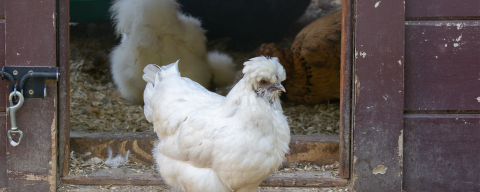How Should I Take Care of Backyard Chickens in the Winter?
Raising backyard chickens can be a rewarding experience for the whole family and it’s a great way to be more self-sufficient. They are relatively easy animals to care for and don’t require a lot of space, so they work well even for people that don’t have a big yard. Here in New Hampshire and other northern states, however, the cold winters require us to take a few extra precautions to make sure that our birds stay happy and healthy in the coldest months.
The Coop Structure
Protection from the elements is one of the most important considerations for keeping chickens warm enough in a cold climate. Specifically, protection from precipitation and wind is paramount. A simple structure with plywood walls around a wooden frame is common for chicken coops, but be sure to seal up gaps that can let in wind, rain, snow and rodents. The roof should be solid and leak-proof. Some people choose to insulate their coops. This helps the space inside stay warmer but isn’t an absolute necessity as protecting your birds from wind is the bigger consideration. A cold wind entering the coop takes away the birds’ natural ability to keep themselves warm. Siding materials other than wood such as corrugated metal will work if it is solid enough to prevent moisture and wind from entering.
Coop Ventilation
While the coop structure needs to keep out wind, rain and snow, it also needs to allow for interior moisture and ammonia gas from chicken droppings to escape. Some vent holes or a small window covered with burlap (not big enough to allow predators to enter) can achieve this but be sure that this is on a side of the structure away from prevailing winds.
Roosting Bars
Chickens prefer to sleep up off the ground so it’s essential to provide interior structures to allow enough space for all your birds to roost. Generally, each chicken requires around 9-12 inches of roosting space. Wood is the best material for this as metal and other materials can hold onto the cold and could result in frostbitten feet. Make sure the roosts are around 1-2 inches wide so that your birds can wrap their toes around the edges. Too narrow and it will be difficult for them to balance, too wide and flat, they won’t have anything to grab onto.
Ground Insulation
If your coop is open to the ground at the bottom, insulate the floor of the coop with 4-6 inches of a natural material such as straw or pine shavings. This will keep some of the cold out and will help prevent frostbite on feet when your birds drop down from their roosts. If you have an enclosed run for your flock, you’ll want to place some bedding down for that area as well.
Supplemental Light
When the daylight drops below around 14 hours per day, chickens will slow their egg production. You can counteract this slowdown by providing supplemental light in the chicken coop to bring it back up to 14-16 hours per day. Make sure to use a lamp that won’t generate too much heat, as this can be a fire hazard. LED bulbs and lamps work well as they don’t generate the heat of an incandescent or fluorescent bulb. Don’t forget to gather eggs frequently to prevent them from freezing as well.
To Heat or Not to Heat
In most circumstances, we advise against adding supplemental heat to your chicken coop. The risk of a heat source causing a fire is too high with combustible bedding materials present and given the tendency of chickens to knock things over. If you’ve built or purchased a coop that is properly constructed, mostly draft-free except for ventilation, and if you’ve followed the advice in this article, it should be enough to limit the danger to your flock from the cold. On the coldest of cold days, you can protect the most vulnerable parts of your birds, the combs and waddles, by smearing on some petroleum jelly to prevent frostbite. There are some instances, however, where it may be appropriate to use supplemental heating, especially if you raise some smaller breeds of chickens. See below for more on that.
Breeds
Despite originally coming from tropical regions, chickens, with their fluffy inner layer of down feathers, are surprisingly hardy birds. Some breeds, however, can withstand the cold better than others. Generally, larger breeds are the hardiest and those with smaller combs have less chance of getting frostbite. If you raise smaller breeds like bantams, you may consider insulating the coop and/or carefully using a specially designed heater for chicken coops with appropriate safety technology. With any supplemental heating, educate yourself about the risks and read all instructions and warnings carefully before installation.
Winter Food and Water Needs
Chickens have been known to eat up to 25% more feed during cold weather so making sure they have enough food is critical. Feeding your birds at the right time can actually help them keep warm as well. When it gets cold, make sure they have free access to their regular food or try giving them some scratch grains in the late afternoon, which will help them generate some body heat overnight as they digest. It’s also important to provide grit to your birds in the wintertime as they won’t have as much opportunity to find small pebbles on the ground if it is covered with insulating straw, etc. Grit helps them to break down food and ensures that they’re able to digest properly.
Making sure your chickens have unlimited access to clean, unfrozen water is essential during the winter. There are a couple of ways of ensuring your birds have the water they need. One is to buy a water heater if you have electricity available. There are many types available from all-in-one systems to simple base heaters placed underneath a bowl. With any electrical appliances in your coop, be aware of the risks and take precautions to prevent fire or harm from electrical shock to your flock. Another option is to use a low-walled rubber bucket which can be overturned, the ice knocked out, and then refilled with fresh water. This is more work and can get dirtier due to its low walls, but it could be the best option if you don’t have electricity close by.
Know the Signs That Your Birds Are Cold
If you start noticing that your chickens are huddling together, lifting a foot, or if they keep fluffing up their feathers, these could be signs that your birds are too cold and are at risk of frostbite. Take a look at the coop to see if it needs any sealing from the wind or if the coop ventilation allows too much airflow. Add more bedding as necessary and be sure that your birds have plenty of food and fresh water. If you suspect that a bird has suffered frostbite, seek the guidance of a veterinarian.
Do you love learning about stuff like this?
SUBSCRIBE TO Granite State Gardening newsletter
Got questions? The UNH Extension Yard and Garden Infoline offers practical help finding answers for your yard and garden questions.
Call toll free at 1-877-398-4769, Monday to Friday, 9 a.m. to 2 p.m., or fill out webform.

